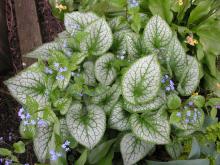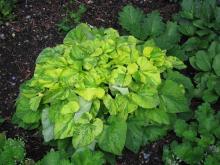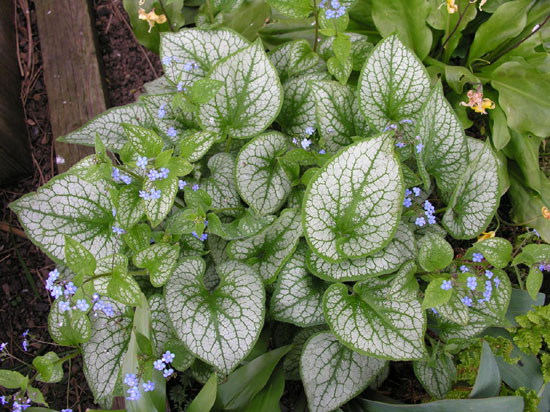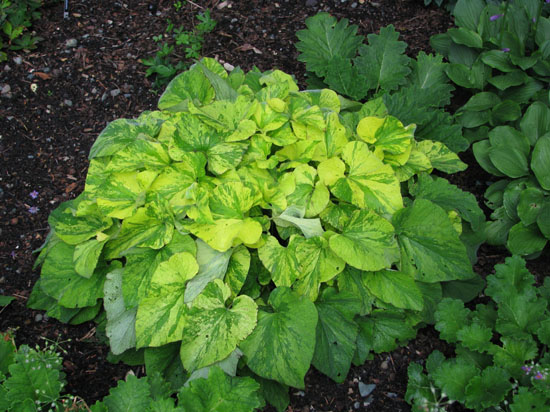The genus Brunnera contains only three species but only one is grown in cultivation, B. macrophylla, a native of eastern Europe. It is a member of the Borage Family, Boraginaceae, being related to such plants as borage, lungwort and Virginian bluebells. The genus was named after a 19th century Swiss botanist named Samuel Brunner.
 In the wild, Brunnera grows in reasonably moist, deciduous woodlands. In the garden, they prefer dappled shade and humus-rich soil. In cooler regions they can tolerate morning sun if the soil remains reasonably moist. In early-mid spring plants produce wiry stems topped with open clusters of blue or rarely white, ‘forget-me-not’ like flowers. At this stage the leaves are still quite small. After blooming, the rounded to heart-shaped leaves increase significantly in size to reach upwards of a foot across. If well grown, these plants can assume the role of a groundcover in shady areas. They are quite deer-resistant. While rated hardy to zone 3, their leaves are prone to scorching if exposed to too much sun or wind.
In the wild, Brunnera grows in reasonably moist, deciduous woodlands. In the garden, they prefer dappled shade and humus-rich soil. In cooler regions they can tolerate morning sun if the soil remains reasonably moist. In early-mid spring plants produce wiry stems topped with open clusters of blue or rarely white, ‘forget-me-not’ like flowers. At this stage the leaves are still quite small. After blooming, the rounded to heart-shaped leaves increase significantly in size to reach upwards of a foot across. If well grown, these plants can assume the role of a groundcover in shady areas. They are quite deer-resistant. While rated hardy to zone 3, their leaves are prone to scorching if exposed to too much sun or wind.
While the wild species is very attractive, in recent years there have been a rash of new cultivars grown primarily for their decorative foliage. Among the older cultivars are ‘Variegata’ (aka ‘Dawson’s White’) with wide, irregular white margins and ‘Hadspen Cream’ with narrower, yellowish-cream margins. ‘Langtrees’ is another older cultivar with silver-spotted margins and is the parent which has lead to the newer silver-leaved cultivars.
 There are currently several selections that range in foliage colour from silver spotted to entirely silver. ‘Emerald Mist’ is a vast improvement over ‘Langtrees’ with margins boldly spotted in silver. ‘Silver Wings’ has silver spotting over the entire leaf. ‘Jack Frost’ was the harbinger of the really silvery-leaved Brunnera and probably the most responsible for the surge in the popularity of the genus. This selection, which was released in 2001, has silver leaves with green veins. ‘Looking Glass’, released in 2003, has foliage is that is essentially completely silver. Hot off the bench is ‘King’s Ransom’ which has the silver leaves of ‘Jack Frost’ but with the added attraction of white-edged leaves!
There are currently several selections that range in foliage colour from silver spotted to entirely silver. ‘Emerald Mist’ is a vast improvement over ‘Langtrees’ with margins boldly spotted in silver. ‘Silver Wings’ has silver spotting over the entire leaf. ‘Jack Frost’ was the harbinger of the really silvery-leaved Brunnera and probably the most responsible for the surge in the popularity of the genus. This selection, which was released in 2001, has silver leaves with green veins. ‘Looking Glass’, released in 2003, has foliage is that is essentially completely silver. Hot off the bench is ‘King’s Ransom’ which has the silver leaves of ‘Jack Frost’ but with the added attraction of white-edged leaves!
Yellow foliage is always in demand and thus plant breeders are now looking at Brunnera as a possible source for yellow-foliaged woodlanders. ‘Spring Yellow’ comes quite close with spring foliage that is heavily spotted in yellow-green lending the leaves a chartreuse colour that contrasts beautifully with the blue flowers. The leaves turn more green as the season progresses. The newest and best of the yellow-variegated selections is ‘Gold Strike’ whose leaves are irregularly streaked and blotched in yellow. This striking colour remains all season.
If you prefer white-flowered woodland plants, then Brunnera can still fit the bill. The cultivar ‘Betty Bowring’ (aka ‘Betsy Baring’) and ‘Marley’s White’ are essentially white-flowered version of the regular species while ‘Mr. Morse’ is a white-flowered version of ‘Jack Frost’ with the silver foliage of that latter cultivar.



